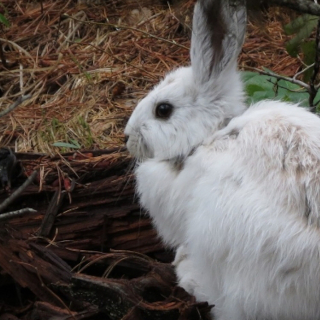Population Dynamics in the Wild: From field data to models to management actions
We are keen to understand how human caused stressors and management can affect wildlife, and in that quest we employ both hard-fought field data, genetic data, and computational models. Here are a few interrelated projects that capture some of these efforts:
Snowshoe hare cycles and responses to forest management
[Paul Griffin, Ellen Cheng, Alex Kumar, Karen Hodges, Carly Walker]
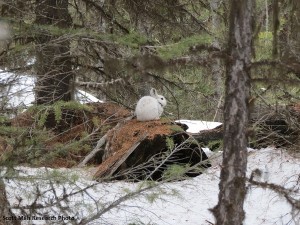 The regularity and spatial synchrony of 10-year snowshoe hare cycles in northern forests are classic textbook phenomena in basic ecology with broad practical importance because hares are a dominant herbivore and the nearly exclusive prey of the federally Threatened Canada lynx. Although well-described in their northern range, hare cycles are essentially unstudied in the continental U.S. In this region, where the persistence of their Federally threatened, specialized predator (lynx) is most tenuous, hare cycles are thought to be dampened and possibly non-synchronous.
The regularity and spatial synchrony of 10-year snowshoe hare cycles in northern forests are classic textbook phenomena in basic ecology with broad practical importance because hares are a dominant herbivore and the nearly exclusive prey of the federally Threatened Canada lynx. Although well-described in their northern range, hare cycles are essentially unstudied in the continental U.S. In this region, where the persistence of their Federally threatened, specialized predator (lynx) is most tenuous, hare cycles are thought to be dampened and possibly non-synchronous.
Our lab group has been estimating abundance with rigorous capture-mark-recapture methods every year since 1998 at some 35 sites in Wyoming and Montana. We have funding from the NSF LTREB program to continue through 2018, which will give us 2 putative cycle lengths of capture-mark-recapture abundance data for at least 21 replicate sites, producing the longest, most rigorous, and most spatially extensive set of hare time series in the conterminous U.S.
We’ve learned a lot already, including how varying forest structure can create source-sink dynamics that can dampen cycles; and that hares move less, but die more, when they are caught on snow under a full moon. We’ve learned how hare densities depend not only on where they live, but also on the structure of the forest in the broader landscape. And now, we’re studying how forests long logged might be restored to conditions that improve hare habitat and numbers.
To uncover mechanisms of synchrony of hares across their range, we reached out to hunters, trappers, and researchers across North America, and collected >300 time series and 1,014 genetic samples from 16 U.S. states and 12 Canadian provinces. We are using the time series to understand patterns of synchrony in population dynamics, and the genetic samples to understand population structuring (see Conservation Genetics section below). In the end, we will understand whether cycles are dampened in the lower 48 states, and what role connectivity versus extrinsic factors plays in affecting the dynamics. Linking the field-based time series to measures of seasonal coat color mismatch will provide a novel and high-profile connection between a visual climate change effect and actual effects on population dynamics.
Marmots, bighorn sheep, cougars, small mammals, fruit bats and more…
[Sue Griffin, Julia Witczuk, Heather Johnson, Jesse Newby, Jenny Pierson, Tammy Mildenstein, David Tallmon, Kevin Lair, Reesa Yale Conroy]
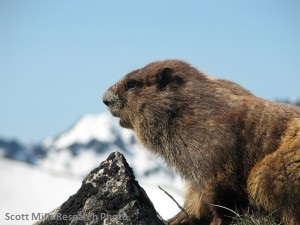 We also work on lots of other species in the field, connecting the field data to population models and genetic tools to give us non-intuitive insights. For example, we worked for several years on peninsular Olympic marmots in Olympic National Park. This is a classic metapopulation-distributed species whose dynamics could seemingly be strongly affected by stressors such as climate change and tourist pressure. Through intensive studies of the marmots we learned that, in fact, the biggest stressor on this species is coyotes, who invaded the Olympic Peninsula high country maybe 30 years ago. We also used non-invasive DNA sampling of carnivore scats to learn more about where coyotes were distributed in the high country, and how broadly marmots were included in their diet.
We also work on lots of other species in the field, connecting the field data to population models and genetic tools to give us non-intuitive insights. For example, we worked for several years on peninsular Olympic marmots in Olympic National Park. This is a classic metapopulation-distributed species whose dynamics could seemingly be strongly affected by stressors such as climate change and tourist pressure. Through intensive studies of the marmots we learned that, in fact, the biggest stressor on this species is coyotes, who invaded the Olympic Peninsula high country maybe 30 years ago. We also used non-invasive DNA sampling of carnivore scats to learn more about where coyotes were distributed in the high country, and how broadly marmots were included in their diet.
We studied endangered Sierra Nevada bighorn sheep through hard-core hiking and sheep surveys above 10,000 feet, intense computational modeling, and genetic analysis. Through this, we developed data-based management recommendations most likely to efficiently recover the species; we also learned that although some inbreeding depression is occurring, it has little population-level effect, and is almost certainly not the biggest threat to the species.
We also studied cougar dispersal ecology in the central Rocky Mountains, and learned that human-caused mortality influences spatial population dynamics.
And for a bunch of years in a bunch of places, we caught small mammals, again linking field data to genetic and population models. We studied edge effects, isolation, gene flow, and effects of logging and highways.
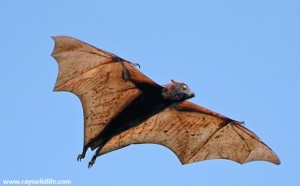 And then there was the big flying mammals, really big: fruit bats in the Philippines, with 6 foot wingspans. A highly endangered species co-exists with, and looks really similar to, a widespread different species. Here, our work was to see how they competed and co-existed, and to try to come up with conservation solutions.
And then there was the big flying mammals, really big: fruit bats in the Philippines, with 6 foot wingspans. A highly endangered species co-exists with, and looks really similar to, a widespread different species. Here, our work was to see how they competed and co-existed, and to try to come up with conservation solutions.
Population Viability and Sensitivity Analysis Modeling
[John Citta, Mike Wisdom (USFS), Rebecca Taylor, lots of other grad students doing creative independent studies]
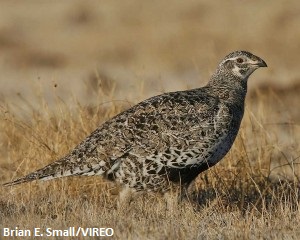 The field studies described above married field data to genetic analysis and population models. But we’ve also worked to develop new conceptual approaches to use population models to help guide conservation management. We’ve thought a lot about incorporating genetic issues into population models, how to account for uncertainty, and how to use sensitivity analyses to figure out which actions would have the highest ‘bang for the buck’ to recover endangered species (or control pests species). Some highlights include incorporating inbreeding depression into stochastic PVA models, comparing PVA models, and sensitivity analysis that had big effects on management and research for species ranging from: waterfowl, to sage grouse, to amphibians declining globally, to invasive brown-headed cowbirds, to bighorn sheep.
The field studies described above married field data to genetic analysis and population models. But we’ve also worked to develop new conceptual approaches to use population models to help guide conservation management. We’ve thought a lot about incorporating genetic issues into population models, how to account for uncertainty, and how to use sensitivity analyses to figure out which actions would have the highest ‘bang for the buck’ to recover endangered species (or control pests species). Some highlights include incorporating inbreeding depression into stochastic PVA models, comparing PVA models, and sensitivity analysis that had big effects on management and research for species ranging from: waterfowl, to sage grouse, to amphibians declining globally, to invasive brown-headed cowbirds, to bighorn sheep.
Interface of Conservation Genetics and Population Ecology
[Mike Schwartz, David Tallmon, Heather Johnson, Ellen Cheng, with help from lots of others]
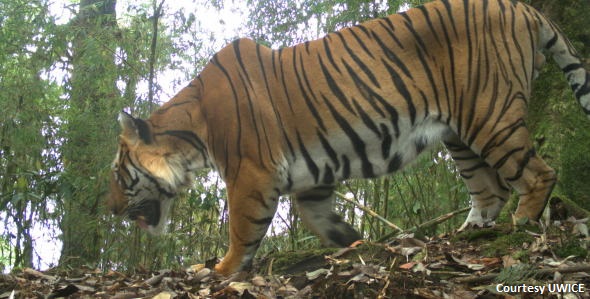 You’ve seen the thread already: we really like to combine field data with population models and conservation genetics to solve conservation problems. We’ve used genetic tools in our studies of small mammals, snowshoe hares, bighorn sheep, flying foxes, snow leopards, tigers and lynx.
You’ve seen the thread already: we really like to combine field data with population models and conservation genetics to solve conservation problems. We’ve used genetic tools in our studies of small mammals, snowshoe hares, bighorn sheep, flying foxes, snow leopards, tigers and lynx.
We’ve also developed theory to employ genetic tools in ecology, conservation, and wildlife biology. We’ve considered the promise and pitfalls of using non-invasive genetic sampling to estimate abundance of hard-to study species. And lots of thinking about how much gene flow is ‘enough’ between fragmented populations, and how to measure it.
